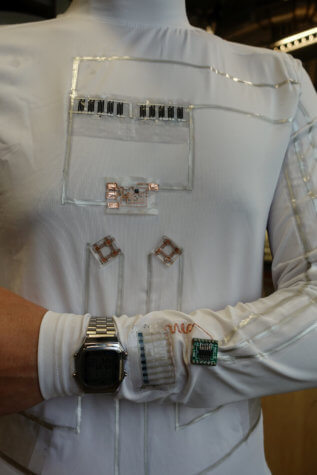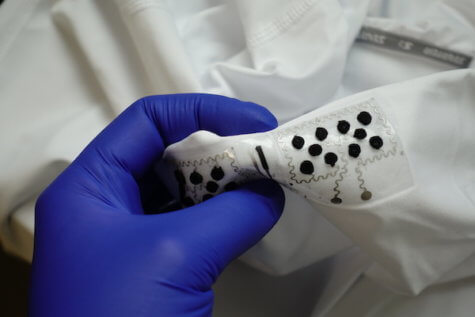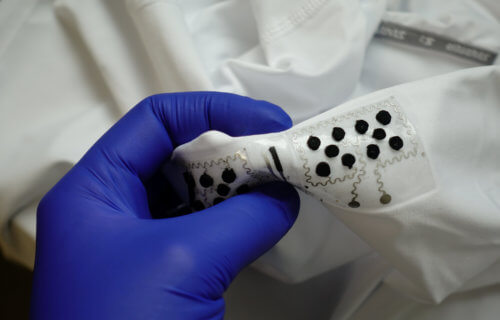SAN DIEGO — What if you could recharge your smartphone simply by going for a jog? Turning exercise into energy for your favorite digital devices may be possible in the not-too-distant future. Nanoengineers have developed a “wearable microgrid” that harvests and stores energy from sweat and movement to power small electronics.
The system is made of sweat-powered biofuel cells, motion-powered devices called triboelectric generators, and energy-storing supercapacitors. All of the parts are flexible and washable — perfect for a shirt.
“We’re applying the concept of the microgrid to create wearable systems that are powered sustainably, reliably and independently. Just like a city microgrid integrates a variety of local, renewable power sources like wind and solar, a wearable microgrid integrates devices that locally harvest energy from different parts of the body, like sweat and movement, while containing energy storage,” says Lu Yin, a nanoengineering doctoral student at the University of California San Diego and one of the creators, in a statement.
Wearable technology taken to the next level

The team first discovered sweat-harvesting wearables in 2013, but have since developed them to become stretchable and powerful enough to run small electronics. In a test, the microgrid was able to continue powering an LCD wristwatch throughout a 30 minute exercise session made up of 10 minutes of running and 20 minutes of rest. While the triboelectric generators provide power as soon as the user starts moving, before breaking a sweat, the biofuel cells kick in when the wearer begins to sweat.
Biofuel cells that harvest energy from sweat are located inside the shirt at the chest. Triboelectric generators that convert energy from movement into electricity are positioned outside the shirt on the forearms and sides of the torso near the waist. Both harvest energy from the swinging movement of the arms against the torso while walking or running, after which supercapacitors outside the shirt on the chest temporarily store energy and discharge it to power small electronics.
“When you add these two together, they make up for each other’s shortcomings. They are complementary and synergistic to enable fast startup and continuous power,” says Yin. He adds that the entire system boots two times faster than having just the biofuel cells alone, and lasts three times longer than the triboelectric generators alone.
The biofuel cells are equipped with enzymes that trigger a swapping of electrons between lactate and oxygen molecules in human sweat to generate electricity. Meanwhile, the triboelectric generators are made of a negatively charged material, placed on the forearms, and a positively charged material, placed on the sides of the torso. As the arms swing against the torso while walking or running, the oppositely charged materials rub against each other and generate electricity.
While the biofuel cells provide continuous low voltage, the triboelectric generators provide pulses of high voltage. Then, both are combined and regulated into a stable voltage by the supercapacitors which act as a reservoir that temporarily stores the energy and discharges it as needed.
Energy possible from sitting down too?
Yin compares the setup to a water supply system. “Imagine the biofuel cells are like a slow flowing faucet and the triboelectric generators are like a hose that shoots out jets of water. The supercapacitors are the tank that they both feed into, and you can draw from that tank however you need to,” he explains.

All of the parts are connected with flexible silver interconnections that are also printed on the shirt and insulated by a waterproof coating. The performance of each part is not affected by repeated bending, folding and crumpling, or washing in water, as long as no detergent is used.
Mr. Yin explains that the main innovation of the work is not the wearable devices themselves but the integration of all the devices. “We’re not just adding A and B together and calling it a system. We chose parts that all have compatible form factors – everything here is printable, flexible and stretchable, matching performance and complementary functionality, meaning they are all useful for the same scenario, in this case rigorous movement,” he says.
The researchers are now working on other designs that can harvest energy while the user is stationary or passive, for example, sitting inside an office or moving slowly outside.
The technology has been reported in the journal Nature Communications.
SWNS writer William Janes contributed to this report.
